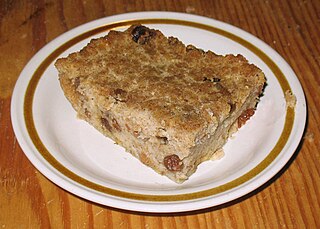
Bread pudding is a bread-based dessert popular in many countries' cuisines. It is made with stale bread and milk or cream, generally containing eggs, a form of fat such as oil, butter or suet and, depending on whether the pudding is sweet or savory, a variety of other ingredients. Sweet bread puddings may use sugar, syrup, honey, dried fruit, nuts, as well as spices such as cinnamon, nutmeg, mace, or vanilla. The bread is soaked in the liquids, mixed with the other ingredients, and baked.

Tom Thumb is a character of English folklore. The History of Tom Thumb was published in 1621 and was the first fairy tale printed in English. Tom is no bigger than his father's thumb, and his adventures include being swallowed by a cow, tangling with giants, and becoming a favourite of King Arthur. The earliest allusions to Tom occur in various 16th-century works such as Reginald Scot's Discovery of Witchcraft (1584), where Tom is cited as one of the supernatural folk employed by servant maids to frighten children. Tattershall in Lincolnshire, England, reputedly has the home and grave of Tom Thumb.

The square academic cap, graduate cap, cap, mortarboard or Oxford cap is an item of academic dress consisting of a horizontal square board fixed upon a skull-cap, with a tassel attached to the centre. In the UK and the US, it is commonly referred to informally in conjunction with an academic gown as a "cap and gown". It is also sometimes termed a square, trencher, or corner-cap. The adjective academical is also used.

A knit cap, colloquially known as a beanie, is a piece of knitted headwear designed to provide warmth in cold weather. It usually has a simple tapered shape, although more elaborate variants exist. Historically made of wool, it is now often made of synthetic fibers.

A baseball cap is a type of soft hat with a rounded crown and a stiff bill projecting in front.

A hat is a head covering which is worn for various reasons, including protection against weather conditions, ceremonial reasons such as university graduation, religious reasons, safety, or as a fashion accessory. Hats which incorporate mechanical features, such as visors, spikes, flaps, braces or beer holders shade into the broader category of headgear.
In New Zealand, the United States, the United Kingdom, and elsewhere, a beanie is a head-hugging brimless cap, sometimes made from triangular panels of material joined by a button at the crown and seamed together around the sides. Beanies may be made of cloth, felt, wool, leather, or silk. In many US regions and parts of Canada the term "beanie" refers to a knitted cap, alternately called a "stocking cap" or a "toque".

Bonnet has been used as the name for a wide variety of headgear for both sexes—more often female—from the Middle Ages to the present. As with "hat" and "cap", it is impossible to generalize as to the styles for which the word has been used, but there is for both sexes a tendency to use the word for styles in soft material and lacking a brim, or at least one all the way round, rather than just at the front. Yet the term has also been used, for example, for steel helmets. This was from Scotland, where the term has long been especially popular.

A side cap is a military cap that can be folded flat when not being worn. It is also known as a garrison cap or flight cap in the United States, wedge cap in Canada, or field service cap in the United Kingdom. In form the side cap is comparable to the glengarry, a folding version of the Scottish military bonnet. It has been associated with various military forces since the middle of the 19th century, as well as various civilian organizations.

Coonass, or Coon-ass, is a term for a person of Cajun ethnicity. Some view it as derogatory, however many Cajuns embrace the name.

Snegurochka (diminutive) or Snegurka, or The Snow Maiden, is a character in Russian fairy tales.
Dunce is a mild insult in English meaning "a person who is slow at learning or stupid". The etymology given by Richard Stanyhurst is that the word is derived from the name of the Scottish scholastic theologian and philosopher John Duns Scotus.

Ashure, Anoushabour, Noah's pudding or Trigo koço is a sweet pudding that is made of a mixture consisting of various types of grains, fresh and dried fruits, and nuts.

The pileus was a brimless felt cap worn in Ancient Greece, Etruria, Illyria, later also introduced in Ancient Rome. The pileus also appears on Apulian red-figure pottery.

Icelandic national costume, collectively known in Icelandic as Þjóðbúningurinn has enjoyed various levels of popularity since the term was coined in Iceland in the 19th century, during the struggle for independence. Since 2001 the national costume is regulated by Þjóðbúningaráð, which preserves the correct techniques of making them and instructs people.

Headgear, headwear, or headdress is any element of clothing which is worn on one's head, including hats, helmets, turbans and many other types. Headgear is worn for many purposes, including protection against the elements, decoration, or for religious or cultural reasons, including social conventions.

A Breton is a woman's hat with a round crown and a deep brim that is turned upwards all the way round, exposing the face. Sometimes the hat has a domed crown. Typically it is worn tilted to the back of the head.

A bumper brim is a millinery feature in which the hat brim is tubular in design, making it a prominent feature of the hat. In order to achieve this effect, the brim may be rolled, stiffened or padded. A bumper brim can be added to a variety of hat designs, from small to large.

Interior with a Child Feeding a Parrot is an oil-on-canvas painting by the Dutch painter Pieter de Hooch. It is an example of Dutch Golden Age painting and is now in a private collection.

The Chapeau à la Paméla, Pamela hat or Pamela bonnet described a type of straw hat or bonnet popular during the 1790s and into the first three quarters of the 19th century. It was named after the heroine of Samuel Richardson's 1741 novel Pamela; or, Virtue Rewarded. While Pamela hats and bonnets underwent a variety of changes in shape and form, they were always made from straw. The mid-19th-century version of the Pamela hat was a smaller version of an early 19th-century wide-brimmed style called the gipsy hat.






















